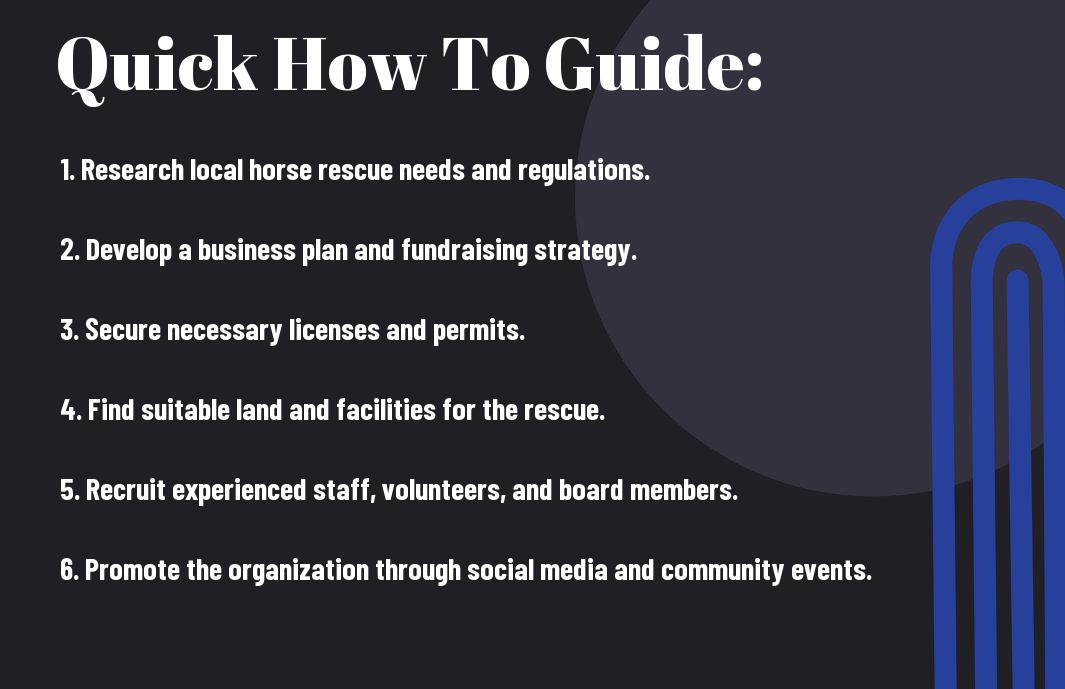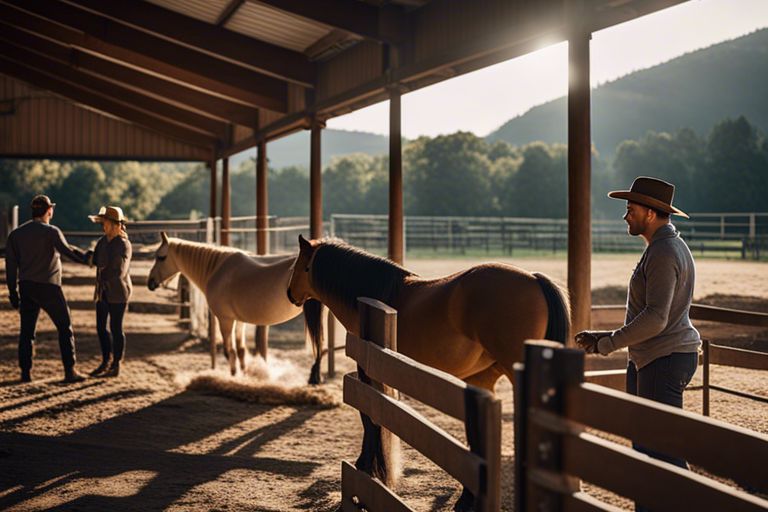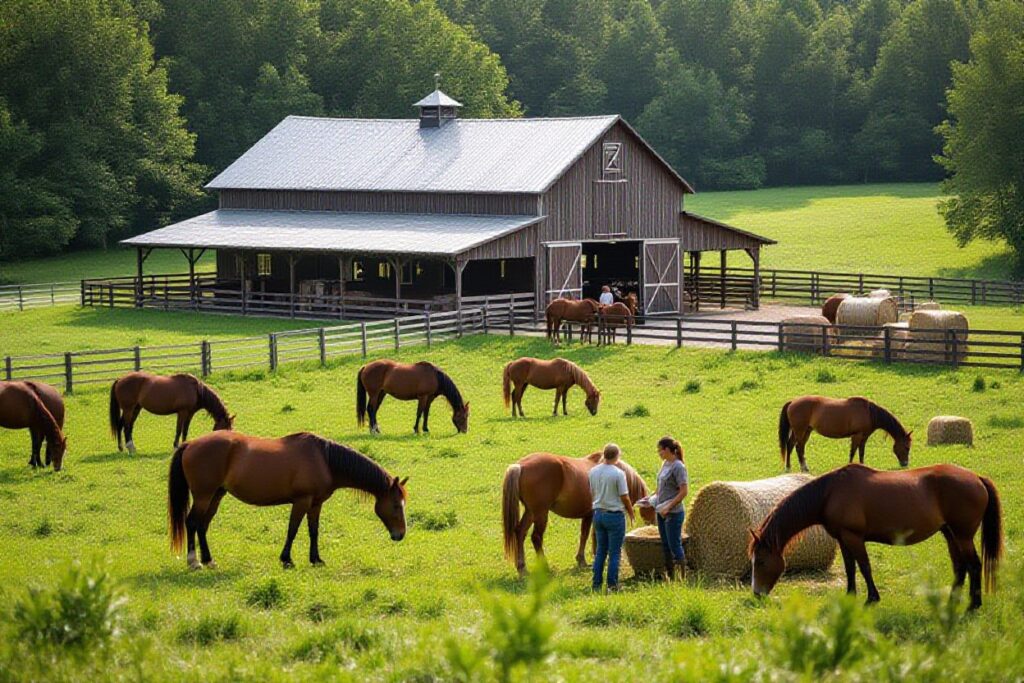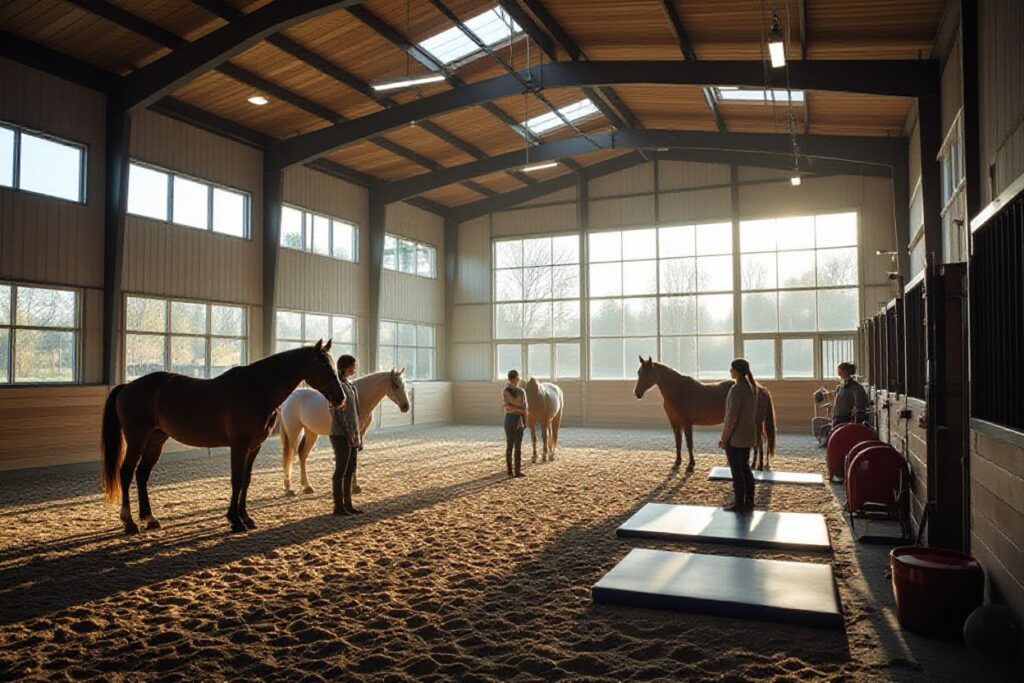Just imagining the impact you could have on saving and rehabilitating horses in need is enough to inspire you to start a horse rescue organization. In this guide, you will find step-by-step instructions on how to start your own horse rescue organization, from creating a mission statement and fundraising to finding the right location and building a dedicated team. With your passion and commitment, you can make a difference in the lives of these magnificent animals.

Understanding the Need for a Horse Rescue Organization
Identifying the Problem of Horse Neglect and Abuse
Your passion for horses has led you to see the harsh reality of neglect and abuse that many horses face. Sadly, not all horses are fortunate enough to receive proper care and treatment. This is where horse rescue organizations play a vital role in stepping in to help these majestic animals in their time of need.
The Importance of Horse Rescue Organizations in the Community
Understanding the significance of horse rescue organizations in the community is crucial. These organizations serve as a lifeline for horses that have been abandoned, abused, or neglected. By providing shelter, medical care, rehabilitation, and ultimately finding new loving homes for these horses, rescue organizations make a profound impact on the well-being of these animals.
Needless to say, the presence of horse rescue organizations can mean the difference between life and death for many horses. Their tireless efforts not only save individual horses but also raise awareness about the importance of proper equine care and welfare in the community. Through education and advocacy, horse rescue organizations create a ripple effect that benefits countless horses and horse owners.

Planning and Research
If you are considering starting a horse rescue organization, planning and research are crucial steps to help ensure your success. This chapter will guide you through the process of conducting market research, analyzing the competition, developing a mission statement, and creating a business plan for your organization.
Tips for Conducting Market Research and Analyzing the Competition
One of the first steps in starting a horse rescue organization is to conduct market research to understand the needs of your community and the demand for horse rescue services. Research other horse rescue organizations in your area to see what services they offer and how you can differentiate your organization. Look into the local horse industry to determine the size of the market and the potential for growth in your area. Any information you gather will help you make informed decisions as you move forward with your organization.
Factors to Consider When Developing a Mission Statement
An imperative part of starting a horse rescue organization is developing a mission statement that clearly outlines your organization’s goals and values. Consider what issues are most important to you and how you want to impact the lives of horses in need. Assume that your mission statement will guide all of your organization’s decisions and activities, so take the time to craft a statement that reflects your passion and commitment to helping horses.
- Passion for horses
- Commitment to animal welfare
- Desire to make a difference. Assume that your mission statement will be the foundation of your organization and will inspire others to support your cause.
How to Create a Business Plan for Your Horse Rescue Organization
With a clear mission statement in place, you can begin to develop a business plan for your horse rescue organization. Consider the operational and financial aspects of running a rescue, including expenses for horse care, facility maintenance, and staffing. Understanding the costs involved will help you create a realistic plan for funding and sustainability.
Consider seeking advice from financial experts or nonprofit consultants to ensure your business plan is thorough and viable. Assumptions regarding fundraising capabilities and partnerships in your community can also be included in your business plan to give potential donors and supporters a clear understanding of your organization’s goals and strategies.

Obtaining Necessary Licenses and Certifications
Understanding State and Local Regulations for Horse Rescues
To start a horse rescue organization, you need to understand the specific regulations that govern animal welfare in your state and local area. This includes zoning laws, licensing requirements, and regulations regarding the care and transport of horses. Make sure you are familiar with the legal framework that you will be operating within to avoid any potential issues.
How to Obtain 501(c)(3) Non-Profit Status
With the goal of starting a horse rescue organization, you must apply for 501(c)(3) non-profit status from the Internal Revenue Service (IRS). This status will not only allow you to accept tax-deductible donations and apply for grants but will also lend credibility to your organization. It is a crucial step in the process of establishing a reputable horse rescue.
Certifications
Importance of Accreditation from National Organizations
The accreditation from national organizations in the animal welfare field can significantly benefit your horse rescue organization. Not only does it validate your commitment to animal welfare and best practices, but it can also open up opportunities for funding, partnerships, and resources. By obtaining accreditation, you demonstrate to donors and supporters that your organization meets high standards set by recognized authorities in the industry.
Building a Strong Team
Factors to Consider When Recruiting Volunteers and Staff
After establishing your horse rescue organization, the next step is to build a strong team of volunteers and staff to help you achieve your mission. When recruiting individuals to join your team, consider factors such as their experience with horses, their commitment to animal welfare, and their availability to dedicate time to the organization.
- Experience: Look for individuals who have experience working with horses and have a passion for helping animals.
- Commitment: Ensure that volunteers and staff are dedicated to the mission and goals of the organization.
- Availability: Consider the time commitment required and ensure that individuals can contribute regularly.
This will help you build a team of individuals who are passionate about animal welfare and committed to the success of your horse rescue organization.
How to Develop a Training Program for Volunteers and Staff
If you want to ensure that your team is well-equipped to handle the responsibilities of working with rescued horses, you should develop a comprehensive training program. This program should cover topics such as horse care, handling techniques, health and behaviour assessment, and emergency procedures.
Tips for Building a Strong Board of Directors
While recruiting volunteers and staff is imperative for the day-to-day operations of your horse rescue organization, building a strong board of directors is crucial for its long-term success. When deciding on individuals to serve on your board, look for those who have experience in nonprofit management, fundraising, legal matters, and horse welfare. Any board member should be committed to the mission of the organization and willing to dedicate time and resources to help it thrive.
- Experience: Seek individuals with relevant experience in areas such as nonprofit management and fundraising.
- Commitment: Ensure that board members are dedicated to advancing the mission of the organization.
- Expertise: Look for individuals with expertise in legal matters or horse welfare to provide valuable insights.
Any board should work together cohesively to make decisions that will benefit the organization in the long run.

Fundraising and Financial Planning
How to Create a Budget for Your Horse Rescue Organization
All successful horse rescue organizations have one thing in common: a solid budget. Creating a budget for your organization is crucial to ensuring financial stability and sustainability. It allows you to track income, expenses, and plan for future growth. Even if you are just starting out, a budget will help you make informed decisions about how to allocate resources and set realistic goals for fundraising efforts.
Tips for Writing Grant Proposals and Soliciting Donations
Writing grant proposals and soliciting donations are crucial skills for any horse rescue organization looking to secure funding. Good grant proposals clearly outline your organization’s mission, programs, and why you need funding. When soliciting donations, be specific about how the donor’s contribution will make a difference for the horses in your care. This personal touch can help make your request more compelling.
- Clearly outline your organization’s mission and goals in all grant proposals
- Personalize donation requests to show donors how their contributions will impact the horses
- Follow up with donors to show appreciation for their support
This personal touch can help make your request more compelling.
Factors to Consider When Planning Fundraising Events
Another important aspect of fundraising is organizing events. These events can help raise awareness for your cause and bring in much-needed funds to support your rescue efforts. When planning events, consider the target audience, location, and the overall cost versus potential revenue. Thinking through these factors will help you maximize the impact of your fundraising events.
- Choose event themes that resonate with your target audience
- Secure sponsorships to offset event costs
- Utilize social media and other marketing channels to promote the event
Thinking through these factors will help you maximize the impact of your fundraising events.
Tips for planning successful fundraising events: Research successful events in your area and adapt their strategies to fit your organization’s needs. Remember to keep the focus on your mission and the well-being of the horses in your care. Thorough planning and attention to detail can make your events memorable and effective fundraising opportunities.
Facilities and Equipment
Many imperative components go into starting a successful horse rescue organization, and having the right facilities and equipment is crucial for the well-being of the horses you will be caring for.
How to Select a Suitable Location for Your Horse Rescue Organization
If you are looking to start a horse rescue organization, choosing the right location is key. You want to find a place that provides ample space for turnout, grazing, and housing facilities. Additionally, access to trails or riding areas can be beneficial for rehabilitating the horses and providing them with enrichment.
Factors to Consider When Building or Renovating Facilities
Even though building or renovating facilities can be a daunting task, it is imperative to consider factors such as adequate shelter, safe fencing, and proper drainage. You also need to think about access to clean water sources, storage facilities for feed and supplies, and an arena or round pen for training and exercising horses. The layout of the facilities should be designed with the safety and comfort of the horses in mind.
- Adequate shelter is imperative to protect the horses from the elements.
- Safe fencing will help prevent injuries and escapes.
- Access to clean water sources is crucial for the health of the horses.
- Storage facilities for feed and supplies help in organization and efficiency.
- The layout of the facilities should prioritize the safety and well-being of the horses.
Tips for Acquiring Necessary Equipment and Supplies
Plus, when it comes to acquiring the necessary equipment and supplies for your horse rescue organization, it’s important to invest in quality tools and materials that will last long-term. Consider purchasing items such as halters, lead ropes, grooming supplies, feeders, and wheelbarrows to assist with the daily care and maintenance of the horses.
There’s no need to buy everything at once; you can gradually build up your inventory as needed. Recognizing the importance of having the right equipment and supplies will ensure that you can provide the best care for the horses in your rescue organization.
- Invest in quality tools and materials that will withstand the rigors of daily use.
- Consider purchasing imperative items such as halters, lead ropes, grooming supplies, feeders, and wheelbarrows.
- Building up your inventory gradually as needed is a smart approach to acquiring equipment and supplies.
- Recognizing the significance of having the right equipment and supplies is crucial for the success of your horse rescue organization.
Rescue horses deserve the best care possible, and having well-designed facilities and the right equipment is imperative for their rehabilitation and well-being. By considering these factors and tips, you can create a safe and nurturing environment for the horses in your care.
Conclusion
Ultimately, starting a horse rescue organization can be a rewarding and impactful endeavor. By following the steps outlined in this guide, you can effectively establish a successful rescue that provides much-needed care and refuge for equines in need. Remember to create a solid business plan, obtain necessary permits and licenses, secure funding, establish partnerships, and prioritize the well-being of the horses in your care.
It is important to continue educating yourself on horse care, rescue operations, and nonprofit management to ensure the sustainability and success of your organization. By dedicating your time and resources to this cause, you can make a positive difference in the lives of horses and contribute to the welfare of animals in your community. Your passion and commitment can truly make a significant impact on the lives of these magnificent animals.
FAQ
Q: What is a horse rescue organization?
A: A horse rescue organization is a non-profit group that helps rescue, rehabilitate, and rehome horses in need of assistance.
Q: How can I start a horse rescue organization?
A: To start a horse rescue organization, you will need to research local laws and regulations, create a business plan, secure funding, establish a network of volunteers, and find a suitable location for the rescue facility.
Q: What are the legal requirements for starting a horse rescue organization?
A: Legal requirements for starting a horse rescue organization may vary depending on your location, but generally, you will need to register as a non-profit organization, obtain any necessary permits or licenses, and comply with animal welfare laws.
Q: How can I fundraise for my horse rescue organization?
A: You can fundraise for your horse rescue organization through various methods such as hosting events, applying for grants, seeking donations from individuals and businesses, creating merchandise to sell, and launching online crowdfunding campaigns.
Q: What are the key considerations when running a horse rescue organization?
A: Key considerations when running a horse rescue organization include ensuring the well-being of the horses in your care, maintaining transparency with donors and supporters, building partnerships with other organizations, and staying up-to-date on best practices in horse care and rescue.











